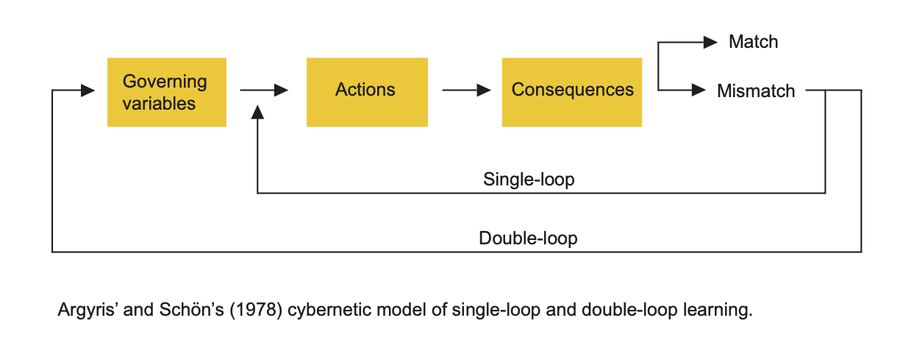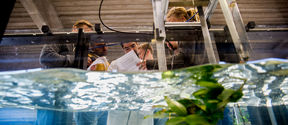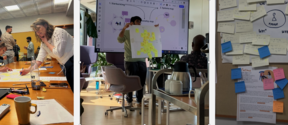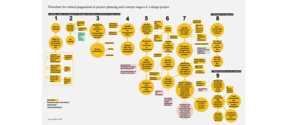What kind of learning does radical creativity imply?
Raine Mäntysalo, professor, HoD, School of Engineering, Department of Built Environment

Introduction
On January 25th, 2023, a workshop was held at the Aalto ENG Department of Built Environment, facilitated by Tua Björklund and Vikki Eriksson from Design Factory. The workshop focused on radical creativity, what it means and how it could be supported. The workshop started with a discussion on what makes creativity radical. Some of the interviews of Aalto researchers that Tua and Vikki had earlier collected, had referred to radical creativity in the sense of creativity in solving problems, while others had referred to radical creativity in the sense of bringing more profound changes in our beliefs and understandings on how problems appear to us in the first place, and what phenomena we see worthy of our attention (Björklund et al., 2022). This latter approach, to conceiving creativity as radical, sounds intuitively more appropriate.
In the workshop, almost all of the participants understood the meaning of radical creativity in a similar way, using phrases such as out-of-the-box thinking, paradigm changing, new and groundbreaking ways of thinking and approaching problems, generating new theoretical and methodological approaches with transformative power, questioning underlying assumptions… One participant asked whether the focus on finding solutions would actually be necessary in radical creativity: “Does it always include a ‘solution’? Can it be a way of working? Or finding a new question or ways of thinking?”
Indeed, should this be the way of conceiving what radical creativity is about – new ways of working and thinking, being predominantly about transforming academic cultures and institutionalized norms, rather than dealing with individual problem-solution framings? Or is it so that in radical creativity we can find these two dimensions becoming dynamically interlinked, as when a radical approach to a given research problem triggers a broader radical change in the academic culture – and further in the surrounding society?
In this paper, I suggest one analytical approach to identifying creativity as radical, and as differentiated from ‘mere’ creativity. For this purpose, I apply Gregory Bateson’s theory of learning. With this analytical perspective, I focus on creativity as an act of learning. What kind of learning is produced by creativity when consider radical? What level of learning should it reach, in distinction to the level of learning reached by ‘mere’ creativity?
Levels of learning
Bateson’s theory of learning (1972/1987) introduces three levels of learning. The first level is about learning by trial and error: if this action is found not to produce the intended consequences, then that action is tried, and so on. Explorative trials are repeated, until the intended consequences are hopefully achieved. In Argyris’s and Schön’s (1978) vocabulary, this is single-loop learning: problem-solving within the context of a given habit, skillset or technical practice. There is a given set of governing variables that determines the identification of the nature of the problem and the available choices to be tried for its solution. As this kind of learning does not challenge existing routines, pregiven assumptions, conceptual and more tangible tools of practice, it can hardly be called creative – not to mention radically creative.
The more difficult problems cannot be solved by relying on existing habitual approaches and readily available tools, but instead they require ‘thinking out of the box’. Argyris and Schön’s (1978) double-loop learning represents this type of ‘higher’ learning. Double-loop learning occurs when one reaches beyond unsuccessful trials to critically examining and altering the ‘governing variables’ of one’s action, or prevailing contextual assumptions that determine one’s overall approach to the problem. Double-loop learning is learning to learn in the sense of learning a new approach to solving problems, when the former approach is found to be unsatisfactory. In Bateson’s theory, this is the second level of learning. In the workshop mentioned above, some associated radical creativity with this type of learning. Indeed, creativity must be involved in such learning that breaks out of conventional problem framings - but is this already radical creativity, or should something more be expected from radically creative learning?
In developing his learning theory, Bateson also initially worked with these two levels of learning, then called ‘proto learning’ and ‘deutero learning’. However, he systematized his learning theory later and added a third level of learning – Learning III – which Argyris and Schön’s theory does not address, not at least in its full extent (Engeström, 1995, p. 86).
Double bind
A key concept in comprehending Bateson’s Learning III is his concept of double bind. The concept stems from his theory of schizophrenia (Bateson, 1972/1987). According to Bateson, a double-bind situation occurs:
- when two orders of messages – messages conveyed through actions and messages explaining these actions – are being communicated in the same self-explaining activity;
- the messages are mutually contradictory;
- the actor is unable to comment on the orders of messages being communicated, to correct his/her discrimination of what order of message to respond to (Bateson, 1972/1987, pp. 206–09).
In other words, a person or a group has a misconception of what they are doing, but at the same time they have developed defenses that prevent them from acknowledging their conception as a misconception. In Bateson’s theory of schizophrenia, a child may develop a schizophrenia when being raised by a parent with these kind of supressed misconceptions of his/her parenting. A parent may not be capable of admitting to him/herself that s/he does not have a loving emotional attachment to his/her child, instead reassuring verbally his/her love to both him/herself and to the child. The child thereby learns to adapt to his/her parent’s continuous self-contradictory behaviour, which includes learning to avoid any reflective notions of this self-contradictory behavioural context. Then, a split self-image may result as the child’s coping mechanism: one to be loved and one to be refused. Here, the child develops a personality-moulding habit of coping with the recurring double bind of contradictory messages from his/her parent. One thus learns to act pathologically – and this is learning of the second level!
Schizophrenia aside, in his later work, Chris Argyris (1993) has shown that such pathological learning is actually typical in organizations, especially those with a strong institutional basis – universities being no exception. They may produce strategies and visions which remain abstract and fail to become rooted in operative action beyond top management circles, or provide a set of new vocabulary for labeling procedures that may change only incrementally in the process, such as the UN Agenda 2030 Sustainable Development Goals that often are merely attached to existing programmes and policies. Ad hoc or incremental action is repeatedly, even ritually, confirmed as strategic. Or there may be a programme or project that is a ‘love child’ of the boss, the dysfunctionalities of which are experienced by all involved, while they all are collectively self-inhibited from voicing, or even thinking about, this dysfuntionality - to prevent the boss from being exposed to embarrassment. Or the dysfunctionalities are projected to a scapegoat, while their nature is rather systemic, and a result of collectively developed self-contradictory action. Argyris calls such organizational activities “defensive routines” and “skilled incompetence”. The organization becomes skilled in routinely conducting self-contradictory policies and develops defensive routines to prohibit reflectivity on these self-contradictions.
In such organizational cultures, conditions of discordance between single-loop and double-loop learning are generated. In a double-bind situation, no changes in actions and their governing variables seem to help in the face of recurring mismatches (Bateson, 1972/1987, p. 302). Yet again an unexpected and disturbing policy decision has been made while (allegedly) following the announced strategy. One is faced with problems, each of which appears to be so specific that no general lessons on how to deal with them can be drawn. Each new problem is as difficult to solve as were the former ones. In a double-bind situation, learning acts follow one another, but no improvement in terms of capability building takes place. In such conditions, the organization has developed pathological routines for addressing problems that no longer enhance learning but seem to lead to unexpected situations and deviating phenomena over and over again.
The most difficult problems for an organization – the double-bind situations – are not posed by the unexpectedly behaving ‘outer’ environment in problem situations, but by the pathological way the organization has learned to approach its environment, through double-loop learning (Mäntysalo, 2000; see also Schmidt-Thomé & Mäntysalo,2014). Being focused on individual problem situations, Argyris and Schön’s theory of single- and double-loop learning does not adequately describe how organizations should deal with their cultural pathologies (Engeström, 1995, p. 86). While growing initially from immediate problem situations, the cultural pathologies are a consequence of a long historical process of contradictory handlings and aspirations. In order to deal with its pathologies, the organization needs the capability to reflect on its own governance culture, including its institutionalized path dependencies. Such a capability is provided by the kind of learning that reaches Level III.[1] It involves grasping reflectively the forces and causalities that more or less together constitute the pathologies of practice behind the regular management of affairs within the organization.
These insights are refined in Yrjö Engeström’s theory of organizational learning that is based, in part, on Bateson’s theory of three learning levels (Engeström, 1987). In broader terms, Engeström’s theory builds on the Cultural-Historical Activity Theory (CHAT) – a theoretical framework that Engeström himself helped to develop. It is closely related to American pragmatism, despite drawing on the work of Soviet(!) psychologists, Lev Vygotsky and A.N. Leontyev (Engeström, 1995). A central difference, however, is CHAT’s approach to social practice as a collective activity system, the nature of which cannot be understood without a historical perspective to the trajectories behind current practice, with its social, psychological, cultural and institutional dimensions (see Leontyev, 1981).
Conclusion
The concept of Learning III provides a perspective to reviewing problem-specific out-of-the-box thinking as a form of creativity. There are more profound problems that we at times are faced with, individually and in our organizations, that are symptomatic of long-standing pathologies, and which, I would like to state, require more radical creativity, for their resolution. What would be radical, in my view, is culturally transformative creativity. That would require learning that reaches the level III. True, it is about experimentation and out-of-the-box thinking, but, moreover, it is also about critically identifying cultural-historical sources of recurring failures in recognizing failures, and carefully analyzing existing institutionalized path dependencies, identifying cracks in their lock-ins, and tapping into moments of opportunity with reflective initiatives, to make them path-breaking and culturally transformative.
References
Argyris, C. 1993. On Organizational Learning. Cambridge MA: Blackwell.
Argyris C. & Schön D. 1978. Organisational Learning: A Theory of Action Perspective. Reading, MA: Addison-Wesley.
Bateson, g. 1987, orig.1972. Steps to an Ecology of Mind. Northvale NJ: Jason Aronson.
Björklund, T. et al. 2022. [toward] radical creativity. Aalto University Design Factory. Available at: https://www.aalto.fi/sites/g/files/flghsv161/files/2022-11/Aalto%20University%20Toward%20Radical%20Creativity%20REPORT%20October%202022.pdf
Engeström, Y. 1987. Learning by Expanding. Helsinki: Orienta-konsultit.
Engeström, Y. 1995. Kehittävä työntutkimus. Perusteita, tuloksia ja haasteita. Helsinki: Hallinnon kehittämiskeskus.
Kolb, D.A. 1984. Experiential Learning. Experience as the Source of Learning and Development. New Jersey NJ: Prentice-Hall.
Leontyev, A.N. 1981. Problems of the Development of the Mind. Moscow: Progress Publishers.
Mäntysalo, R. 2000. Land-use Planning as Inter-organizational Learning. Oulu: Acta Universitatis Ouluensis Technica C 155.
Schmidt-Thomé, K. & Mäntysalo, R. 2014. Interplay of power and learning in planning processes: A dynamic view,Planning Theory 13 (2), 115-135.
[1] Kolb’s theory of experimental learning includes “integrative learning” that is based on “third-order feedback” (Kolb, 1984, pp. 156–60, and pp. 224–28), but the theory does not involve a description of whether and how such learning would contribute to the resolution of the type of dilemmas that have a double-bind character. Bateson’s theory of three levels of learning is systemic and dynamic in the sense that each higher level of learning provides a resolution to contradictions experienced in the lower level of learning.
Show other posts from this blog

The role of infrastructure in facilitating cross-disciplinarity
Hybrid concepts and metaphors across disciplines are created by working together in concrete material-spatial conditions.
Professional Cultures as an Obstacle and an Enabler for Radical Transdisciplinary Creativity
Professional cultures are largely invisible but transdisciplinary work requires recognizing and addressing their effect.
Leadership for organizational creativity—creating conditions for creativity
While creativity arguably is a skill or capacity of an individual, it also requires collective effort and empowering leadership.